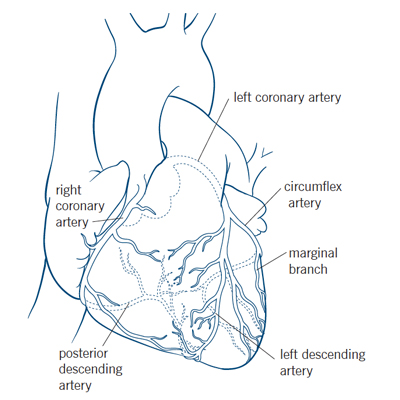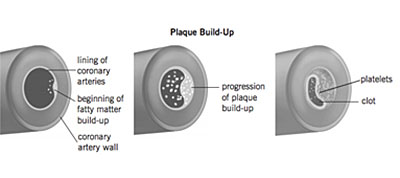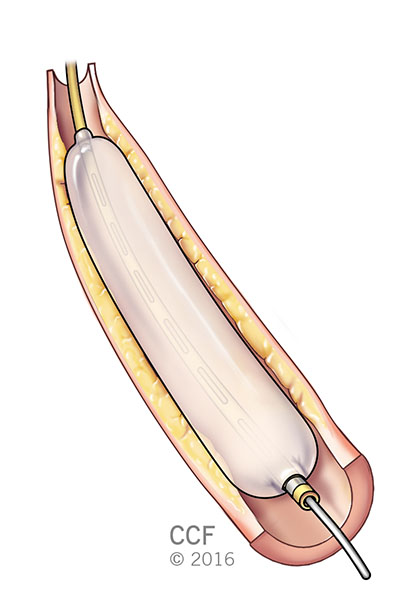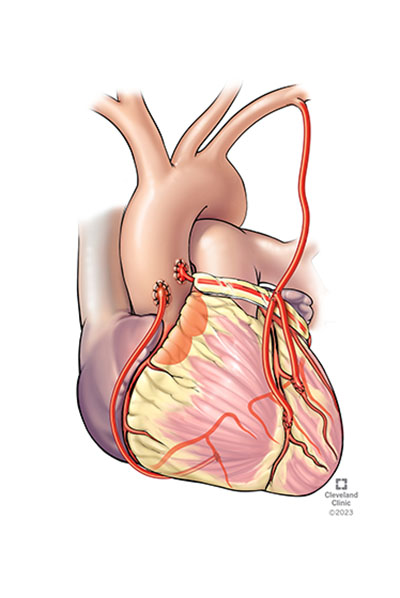What is Coronary Artery Disease?

What is Coronary Artery Disease?
Coronary artery disease is the narrowing or blockage of the coronary arteries, usually caused by atherosclerosis. Atherosclerosis (sometimes called “hardening” or “clogging” of the arteries) is the buildup of cholesterol and fatty deposits (called plaques) on the inner walls of the arteries. These plaques can restrict blood flow to the heart muscle by physically clogging the artery or by causing abnormal artery tone and function. Without an adequate blood supply, the heart becomes starved of oxygen and the vital nutrients it needs to work properly. This can cause chest pain called angina. If blood supply to a portion of the heart muscle is cut off entirely, or if the energy demands of the heart become much greater than its blood supply, a heart attack (injury to the heart muscle) may occur.
Causes

What causes the coronary arteries to narrow?
Your coronary arteries are shaped like hollow tubes through which blood can flow freely. The muscular walls of the coronary arteries are normally smooth and elastic and are lined with a layer of cells called the endothelium. The endothelium provides a physical barrier between the blood stream and the coronary artery walls, while regulating the function of the artery by releasing chemical signals in response to various stimuli.
Coronary artery disease starts when you are very young. Before your teen years, the blood vessel walls begin to show streaks of fat. As you get older, the fat builds up, causing slight injury to your blood vessel walls. Other substances traveling through your blood stream, such as inflammatory cells, cellular waste products, proteins and calcium begin to stick to the vessel walls. The fat and other substances combine to form a material called plaque.
Over time, the inside of the arteries develop plaques of different sizes. Many of the plaque deposits are soft on the inside with a hard fibrous “cap” covering the outside. If the hard surface cracks or tears, the soft, fatty inside is exposed. Platelets (disc-shaped particles in the blood that aid clotting) come to the area, and blood clots form around the plaque. The endothelium can also become irritated and fail to function properly, causing the muscular artery to squeeze at inappropriate times. This causes the artery to narrow even more.
Sometimes, the blood clot breaks apart, and blood supply is restored. In other cases, the blood clot (coronary thrombus) may suddenly block the blood supply to the heart muscle (coronary occlusion), causing one of three serious conditions, called acute coronary syndromes.
Symptoms
What are acute coronary syndromes?
Unstable angina: This may be a new symptom or a change from stable angina. The angina may occur more frequently, occur more easily at rest, feel more severe, or last longer. Although this can often be relieved with oral medications, it is unstable and may progress to a heart attack. Usually more intense medical treatment or a procedure are required to treat unstable angina.
Non-ST segment elevation myocardial infarction (NSTEMI): This type of heart attack, or MI, does not cause major changes on an electrocardiogram (ECG). However, chemical markers in the blood indicate that damage has occurred to the heart muscle. In NSTEMI, the blockage may be partial or temporary, so the extent of the damage is relatively minimal.
ST segment elevation myocardial infarction (STEMI): This type of heart attack, or MI, is caused by a prolonged period of blocked blood supply. It affects a large area of the heart muscle, and causes changes on the ECG as well as in blood levels of key chemical markers.
However, heart muscle damage can be mitigated or even prevented with prompt opening of the obstructed artery.
Some people have symptoms that indicate they may soon develop an acute coronary syndrome, others may have no symptoms until something happens, and still others have no symptoms of the acute coronary syndrome at all.
All acute coronary syndromes require emergency evaluation and treatment.
Collateral Circulation
As the size of the blockage in a coronary artery increases, the narrowed coronary artery may develop “collateral circulation.” Collateral circulation is the development of new blood vessels that reroute blood flow around the blockage. However, during times of increased exertion or stress, the new arteries may not be able to supply enough oxygenrich blood to the heart muscle.
What is ischemia?
Ischemia is a condition described as “cramping of the heart muscle.” Ischemia occurs when the narrowed coronary artery reaches a point where it cannot supply enough oxygen-rich blood to meet the heart’s needs. The heart muscle becomes “starved” for oxygen.
Ischemia of the heart can be compared to a cramp in the leg. When someone exercises for a very long time, the muscles in the legs cramp up because they’re starved for oxygen and nutrients. Your heart, also a muscle, needs oxygen and nutrients to keep working. If the heart muscle’s blood supply is inadequate to meet its needs, ischemia occurs, and you may feel chest pain or other symptoms.
Ischemia is most likely to occur when the heart demands extra oxygen. This is most common during exertion (activity), eating, excitement or stress, or exposure to cold. When ischemia is relieved in less than 10 minutes with rest or medications, you may be told you have “stable coronary artery disease” or “stable angina.” Coronary artery disease can progress to a point where ischemia occurs even at rest.
Ischemia, and even a heart attack, can occur without any warning signs and is called “silent” ischemia. Silent ischemia can occur among all people with heart disease, though it is more common among people with diabetes.
What are the symptoms of coronary artery disease?
The most common symptom of coronary artery disease is angina (also called angina pectoris). Angina is often referred to as chest pain. It is also described as chest discomfort, heaviness, tightness, pressure, aching, burning, numbness, fullness, or squeezing. It can be mistaken for indigestion or heartburn. Angina is usually felt in the chest, but may also be felt in the left shoulder, arms, neck, back or jaw.
Other symptoms that may occur with coronary artery disease include:
- Shortness of breath
- Palpitations (irregular heartbeats, skipped beats or a “flip-flop” feeling in your chest)
- A faster heartbeat
- Dizziness
- Nausea
- Extreme weakness
- Sweating
If you experience any of these symptoms, it is important to call your doctor, especially if these are new symptoms or if they have become more frequent or severe.
Symptoms in Women:
Women often have different symptoms of coronary artery disease than men. For example, symptoms of a heart attack in women include:
- Pain or discomfort in the chest, left arm or back
- Unusually rapid heartbeat
- Shortness of breath
- Nausea or fatigue
If any of these symptoms occur, it is important to get medical help right away - call 9-1-1 or have someone take you to the nearest emergency room.
What you should do if you have symptoms:
If you or someone you are with has chest, left arm or back pain that lasts more than 5 minutes, with one or more of the symptoms listed previously, call 911 to get emergency help. DO NOT WAIT. Quick treatment of a heart attack is very important to reduce the amount of damage to your heart.
Aspirin: After calling 911, emergency personnel may tell you to chew one full (325 mg) aspirin slowly, if you do not have a history of aspirin allergy or bleeding. Aspirin is especially effective if taken within 30 minutes after the start of symptoms. Do NOT take an aspirin for symptoms of a stroke.
- If your symptoms stop completely in 5 minutes, still call your doctor to report your symptoms.
- Call your doctor if this is the first time you have experienced these symptoms so you can be evaluated.
- Learn to recognize your symptoms and the situations that cause them.
- Call your doctor if you have new symptoms or if they become more frequent or severe.
What’s the difference between angina and a heart attack?Angina is a warning symptom of heart disease – but it is not a heart attack. The symptoms of a heart attack (also called myocardial infarction or “MI”) are similar to angina. |
|
| Angina | Heart Attack |
| Is brought on by a brief period of poor blood supply to the heart muscle. | Occurs when the blood supply to the heart muscle is blocked for an extended period of time (often due to a clot forming in a partially blocked coronary artery). |
| Does not cause permanent damage to the heart. | Results in permanent damage to the heart muscle. |
| Symptoms last just a few minutes and are usually relieved by rest and/or medications. Symptoms include chest pain or discomfort, shortness of breath, palpitations, faster heart rate, dizziness, nausea, extreme weakness and sweating. | Symptoms usually last more than a few minutes and include chest pain or discomfort that lasts for more than a few minutes or goes away and comes back; pain or discomfort in other areas of the upper body; difficulty breathing or shortness of breath; sweating or “cold” sweat; fullness, indigestion or choking feeling; nausea or vomiting; light-headedness; extreme weakness; anxiety; rapid or irregular heartbeats. |
| Symptoms are relieved by rest and/or medications within a few minutes. | Symptoms are not relieved by rest or oral medications. |
| Does not require emergency medical attention; however, it is important to call your doctor if this is the first time you’ve experienced angina, if you have new symptoms or if they become more frequent or severe. | Requires emergency medical attention if symptoms last longer than 5 minutes. |
If you have been prescribed nitroglycerin and experience angina: Stop what you are doing and rest. Take one nitroglycerin tablet and let it dissolve under your tongue, or if using the spray form, spray it under your tongue. Wait 5 minutes. If you still have angina after 5 minutes, call 911 to get emergency help.
For patients diagnosed with chronic stable angina: If you experience angina, take one nitroglycerin tablet and let it dissolve under your tongue, repeating every 5 minutes for up to 3 tablets spanning 15 minutes. If you still have angina after taking 3 doses of nitroglycerin, call 911 to get emergency help.
Reference: ACC/AHA 2007 Guidelines for the Management of Patients With Unstable Angina/Non–ST-Elevation Myocardial Infarction. Journal of the American College of Cardiology, 2007. 50(7):1-157.
Use of aspirin with unstable chest pain: After calling 911, emergency personnel may tell you to chew one full aspirin (325 mg) slowly, if you do not have a history of aspirin allergy or bleeding. Aspirin is especially effective if taken within 30 minutes after the start of symptoms. Do NOT take an aspirin for symptoms of stroke. Continue to take your nitroglycerin as prescribed.
Diagnosis
How is coronary artery disease diagnosed?
Your doctor diagnoses coronary artery disease by talking to you about your symptoms, reviewing your medical history and risk factors, and performing a physical exam.
Diagnostic tests, including blood tests, an electrocardiogram (ECG or EKG), exercise or pharmacologic stress tests, coronary computed tomography (coronary CTA) or cardiac catheterization may be required to appropriately diagnose and treat coronary artery disease. These tests help your doctor evaluate the extent of your coronary heart disease, its effect on the function of your heart, and the best form of treatment for you.
Risk Factors
What are the risk factors for coronary artery disease?
Non-modifiable risk factors (those that cannot be changed) include:
- Male gender. The risk of heart attack is greater in men than in women, and men have heart attacks earlier in life than women. However, at age 70 and beyond, men and women are equally at risk.
- Advanced age. Coronary artery disease is more likely to occur as you get older, especially after age 65.
- Family history of heart disease. If your parents have heart disease (especially if they were diagnosed with heart disease before age 50), you have an increased risk of developing it. Ask your doctor when it’s appropriate for you to start screenings for heart disease so it can be detected and treated early.
- Race. African Americans have more severe high blood pressure than Caucasians and therefore have a higher risk of heart disease. Heart disease risk is also higher among Mexican Americans, American Indians, native Hawaiians and some Asian Americans. This is partly due to higher rates of obesity and diabetes in these populations.
Modifiable risk factors (those you can treat or control) include:
- Cigarette smoking and exposure to tobacco smoke
- High blood cholesterol and high triglycerides --especially high LDL or “bad” cholesterol over 100 mg/dL and low HDL or “good” cholesterol under 40 mg/dL. However, interpretation of the cholesterol levels should be integrated with the individual’s clinical history. Always review your results with your doctor for a personalized assessment of your cholesterol levels to determine the appropriate treatment.
Do not wait to get help
At the first signs of a heart attack, call for emergency treatment (911). Do not wait for your symptoms to “go away.” Early recognition and treatment of heart attack symptoms can reduce the risk of heart damage and allow treatment to be started immediately. Even if you’re not sure your symptoms are those of a heart attack, you should still be evaluated.
- High blood pressure (140/90 mm/Hg or higher)
- Uncontrolled diabetes
- Physical inactivity
- Being overweight (body mass index or BMI from 25-29 kg/m2) or being obese (BMI higher than 30 kg/m2 ) NOTE: How your weight is distributed is important. Your waist measurement is one way to determine fat distribution. Your waist circumference is the measurement of your waist, just above your navel. The risk of cardiovascular disease increases with a waist measurement of over 35 inches in women and over 40 inches in men.
- Uncontrolled stress or anger
- Diet high in saturated fat and cholesterol
- Drinking too much alcohol
The more risk factors you have, the greater your risk of developing coronary artery disease.
Treatments
How is coronary artery disease treated?
Treatment for coronary artery disease involves reducing your risk factors, taking medications as prescribed, possibly undergoing invasive and/or surgical procedures and seeing your doctor for regular visits. Treating coronary artery disease is important to reduce your risk of a heart attack or stroke.
REDUCE YOUR RISK FACTORS Reducing your risk factors involves making lifestyle changes. Your doctor will work with you to help you make these changes.
If you smoke, you should quit.
Make changes in your diet to reduce your cholesterol, control your blood pressure, and manage blood sugar if you have diabetes. Lowfat, low-sodium and low-cholesterol foods are recommended. Limiting alcohol to no more than one drink a day is also important. A registered dietitian can help you make the right dietary changes. Cleveland Clinic offers nutrition programs and classes to help you reach your goals.
Increase your exercise/activity level to help achieve and maintain a healthy weight and reduce stress. But, check with your doctor before starting an exercise program. Ask your doctor about participating in a cardiac rehabilitation program.
As a general guidelines, The American Heart Association recommends 150 minutes a week of moderate intensity exercise for overall cardiovascular health. However, something is better than nothing. Simple changes in daily habits can help you increase your activity level. For example, park further, avoid elevators and escalators, or set alarms to remind you to stand or go for a short walk during your work day.
TAKE MEDICATIONS AS PRESCRIBED
If lifestyle changes aren’t enough to control your heart disease, medications may be prescribed to treat certain risk factors, such as high cholesterol or high blood pressure. The medications prescribed will depend on your personal needs, presence of other health conditions and your specific heart condition.
HAVE PROCEDURES TO TREAT CORONARY ARTERY DISEASE, AS RECOMMENDED
Coronary artery revascularization

Your doctor may recommend a medical procedure to improve the blood flow to the heart muscle, also called coronary revascularization. Revascularization can be achieved via a catheter procedure called percutaneous coronary intervention (PCI) or with coronary artery bypass graft (CABG) surgery.
Percutaneous coronary intervention (PCI)
Percutaneous coronary intervention (PCI) refers to non-surgical procedures performed by a cardiologist through a tube or catheter inserted into a blood vessel, rather than by a surgeon through an incision. PCI may consist of balloon angioplasty (PTCA) and stent or drug-eluting stent placement. Several types of balloons and/or catheters are available to treat the plaque within the vessel wall. The physician chooses the type of procedure based on individual patient needs.
Coronary artery bypass graft (CABG) surgery

One or more blocked coronary arteries are bypassed by a blood vessel graft to restore normal blood flow to the heart. These grafts usually come from the patient’s own arteries and veins located in the chest, arm or leg. The graft goes around the clogged artery (or arteries) to create new pathways for oxygen-rich blood to flow to the heart.
Follow-Up Care
Your cardiologist (heart doctor) will want to see you on a regular basis for a physical exam and possibly to perform diagnostic tests. Your doctor will use the information gained from these visits to monitor the progress of your treatment. Check with your heart doctor to find out when to schedule your next appointment.
Important Note: These procedures increase blood supply to your heart, but they do not cure coronary heart disease. You will still need to decrease your risk factors by making lifestyle changes, taking medications as prescribed and following your doctor’s recommendations to reduce the risk of future disease.
Who is affected by coronary artery disease?
Heart disease is the leading cause of death in the United States in men and women. Coronary artery disease affects 16.5 million Americans. The American Heart Association (AHA) estimates that about every 40 seconds, an American will have a heart attack. The lifetime risk of having cardiovascular disease varies according to presence of risk factors. In those with an optimal risk factor profile, the lifetime risk is 3.6% for males and < 1% for females. In those with 2 or more major risk factors, the lifetime risk of coronary artery disease is 37.5% for males and 18.3% for females.
Why Choose Us
The Robert and Suzanne Tomsich Department of Cardiology bring a multidisciplinary approach to the diagnosis and treatment of patients who have mild to severe ischemic coronary heart diseases. The Department of Cardiology is a key component of the Cleveland Clinic Florida Heart and Vascular Institute which offers a complete program of cardiac subspecialties including, cardio thoracic surgery, cardiac electrophysiology, cardio-oncology, vascular medicine and surgery, heart failure and assist devices program and heart transplantation. Cleveland Clinic Florida continues to grow as one of the region’s leading referral centers for cardiac care. We are proud to provide our community with access to the nation’s #1 program for heart care.
Our Center provides:
- A thorough evaluation of patients utilizing the industry’s latest diagnostic testing technology and therapies
- Multi-disciplinary approach to comprehensive care for patients with advanced ischemic diseases
- Ongoing research and education to provide patients with high-quality and innovative therapies
Appointments
For more information about Cleveland Clinic Florida’s Heart and Vascular Institute or to schedule an appointment, please visit us online or call 877.463.2010.
Chat with a Heart Nurse
For over 15 years Heart & Vascular resource nurses have been offering assistance to people who have questions or concerns about heart and vascular conditions. Nurses are available to help with questions on symptoms, diagnoses, treatment options, Cleveland Clinic services and doctors, etc. The nurses are available weekdays from 8:30 a.m. – 4 p.m., Eastern Time, through phone, secure live chat or email. If you need help, you may contact a nurse.
MyConsult® Online Medical Second Opinion
MyConsult Online Second Opinion program connects patients to the expertise of top Cleveland Clinic specialists without the time and expense of travel. Through our secure web platform, patients can submit their detailed health information, medical records and diagnostic test results. The most appropriate Cleveland Clinic expert is assigned to the consultation and will render a detailed second opinion. The report includes commentary about the diagnosis and treatment options or alternatives and recommendations regarding future therapeutic considerations. Patients are also able to send additional questions to the physician who provided the report. Online medical second opinions are available for more than 1,200 medical diagnoses.
